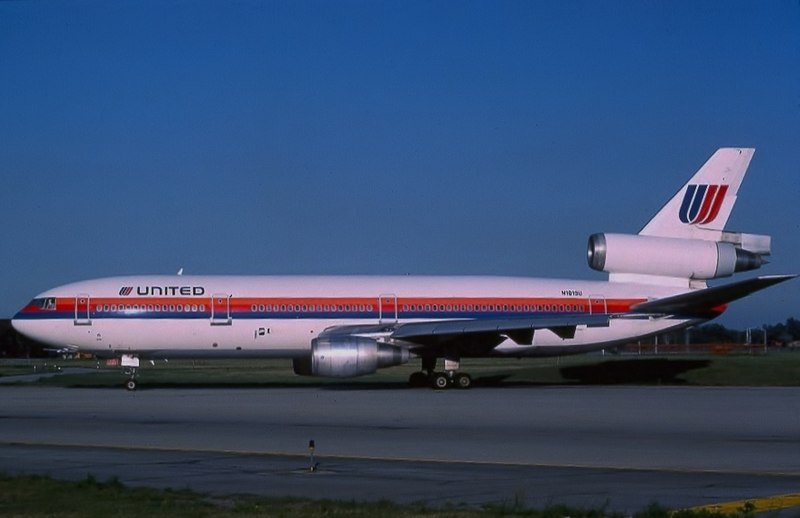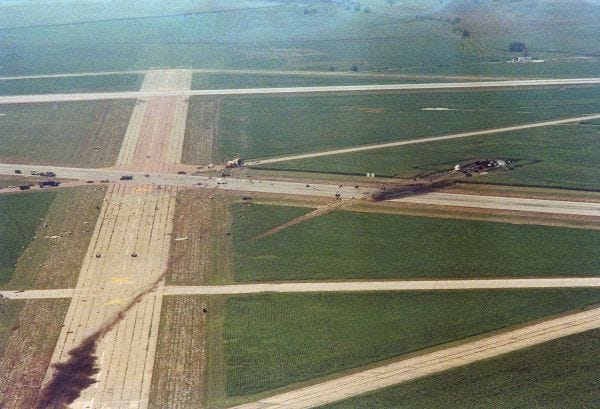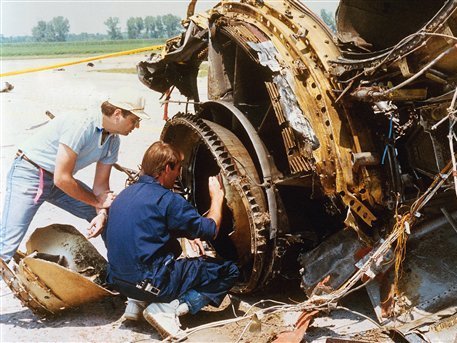Syed Hassaan Khalid continues his series of articles looking at the world’s most notable aviation disasters and incidents.
In this episode he looks at the “unthinkable journey” of United Airlines flight 232 at Sioux City on 19th July 1989.
Read Episode 1 looking at the Tenerife Airport Disaster of 1977.
Read Episode 2 looking at the Helios 522 disaster in 2005.
Read Episode 3 looking at the Germanwings 9525 disaster in 2015.
Read Episode 4 looking at PIA 268 in 1992.
Prologue – United Airlines Flight 232

N1819U, the DC-10 involved in the accident.
On a seemingly routine journey from Denver to Chicago, United Airlines Flight 232 embarked through the Midwestern skies, expecting an uneventful flight. The McDonnell Douglas DC-10, cruising steadily, faced an unforeseen crisis as one of its engines suffered a catastrophic failure, setting off a chain of events that would challenge the crew and passengers in an unprecedented way.
This was no ordinary flight; it became one of the darkest days in aviation history.
Let’s delve into the harrowing story of United Airlines Flight 232.
The Incident

The crash site showing the trajectory of the aircraft at Sioux Gateway.
It is a regular day at Denver’s Stapleton International Airport (DEN), on 19th July, 1989.
At about 2pm, United 232 is preparing for its afternoon flight to Philadelphia via Chicago. The assigned aircraft for this flight is a DC-10-10; registered as N1819U. Luckily, it is to be flown by a veteran crew, Captain Alfred Haynes, with over 29,000 hours of flight time under his belt, and First Officer William Records, totaling around 20,000 hours of flight experience.
The DC-10 lifts off towards the clear skies at 2:09pm and maintains a positive climb towards its assigned flight level. There are 296 souls onboard, comprising of 285 passengers and 11 crew members. A few minutes after reaching the cruising altitude of 37,000ft, a loud bang is heard by all passengers and the crew.
Initially, the captain deems it to be a bomb that has exploded in the passenger cabin or the cargo holds, but upon inspecting the instruments he notices the number 2 has started to malfunction. This is the central engine located in the tail. This does not trouble the captain much as he is aware that the DC-10 can fly comfortably on engines 1 and 3, so he decides to shut down engine no. 2.
On further assessment of the systems, the flight engineer reports that the hydraulics of all three engines is failed as well; the pilots enter a state of denial, as shutting down one engine should not have interfered with the other engines.
Now the first officer announces he is unable to steer the aircraft. He turns the yoke all the way towards left while giving it a pull, however, DC-10 continues banking towards the right.
After a few unsuccessful tries, the captain decides to bring the left engine to idle position and raise the power of the right engine, and eventually is able to level the aircraft again.
While the pilots are battling with the controls, the flight engineer Dudley Dvorak reports another mishap to the captain; there is no hydraulic fluid present in any of the three the systems. With almost no room to continue the flight towards Chicago, Air Traffic Control directs Flight 232 to divert to the nearest possible airfield, which is the Sioux Gateway airport, located in Woodbury County, Iowa. The flight crew starts executing the challenging descend without hydraulic systems functioning.
The next few minutes of the flight is more like a rollercoaster ride, but finally they get sight of the runway. Relief lasts merely a few seconds when they realise that, unfortunately, it is the shorter runway of the airport.
The pilots can’t take the risk of circling the airfield to establish the approach on the main runway, hence, they continue proceeding towards the touchdown point of the shorter strip. The proximity buzzer goes off as the aircraft descends six times faster than normal, and about 150kph faster than the standard approach speed.
The aircraft collides with the runway at 4pm local time, skidding along as the right wing breaks apart along with the cockpit and the tail. The aircraft comes to a halt after scattering its debris throughout the airfield.
Unfortunately, the impact with the ground and smoke inhalation takes the lives of 112 of the occupants.
The Investigation

National Transportation Safety Board investigators check over the burnt remains of a jet engine from the DC-10.
The National Transportation Safety Board (NTSB) launched a full-scale investigation into the crash of United Airlines Flight 232. They were assisted by representatives from the Federal Aviation Administration (FAA), United Airlines, General Electric, McDonnell Douglas, and other organizations. They tried to gather every valuable piece of evidence, but could not locate the disk and the fan blades of the rear engine as it seemingly ruptured and blew far away from the wreckage site.
These parts were deemed essential to continue the investigation as it was the same engine that started the trouble.
Finally, about three months after the incident, a local farmer found the disk with most of the blades still intact. Thus, the full-scale investigation got a new lease of life.
The investigation team had four main objectives: to determine the cause of the engine failure, to evaluate the performance of the flight crew and the air traffic controllers, to analyze the survivability of the passengers and crew, and to issue recommendations for improving safety and preventing similar accidents in the future.
The investigators recovered the engine parts and examined them in a laboratory. They discovered a fatigue crack in the fan disk that had originated from a subsurface defect. The crack had been present for a long time and had escaped detection during previous inspections. The investigators concluded that the crack had grown to a critical size and caused the disk to fracture, sending shrapnel into the hydraulic lines that controlled the flight surfaces.
The second objective was to assess how the flight crew and the air traffic controllers handled the emergency situation. The investigators listened to the cockpit voice recorder (CVR) and the air traffic control (ATC) tapes, and interviewed the survivors and witnesses. They praised the crew for their exceptional professionalism and resourcefulness in attempting to control the airplane with only differential thrust. The investigators noted that the crew had received some valuable assistance from a DC-10 instructor pilot who happened to be on board as a passenger. He had joined them in the cockpit and helped them adjust the engine power settings.
Finally, the investigators issued several recommendations to various entities involved in aviation. These recommendations covered areas such as engine design, inspection methods, maintenance practices, flight training etc. Some of these recommendations were: developing more reliable methods for detecting cracks in fan disks, requiring more frequent inspections of fan disks, installing backup hydraulic systems or flight control systems on DC-10 aircraft and providing more realistic simulator training for pilots on handling engine failures and loss of hydraulics.
Conclusion

Memorial to the victims of UA232 in Sioux City. TheCatalyst31, CC0, via Wikimedia Commons
This incident marked one of the most terrifying days not just in the US, but also to every individual concerned with aviation one way or the other.
Despite the tragedy, the crew of flight 232 gave professional and swift response in the emergency, which eventually saved numerous lives. However, it raised a question mark again on the safety record of the McDonnell Douglas DC-10, which had already seen other incidents such as the American Airlines flight 96, and Turkish Airlines flight 981.
As a result, there was significant decline in the overall reputation of the DC-10, which took a long time to recover from. In 1997, McDonnell Douglas merged with Boeing.




